BAE Systems Hawk
| Hawk | |
|---|---|
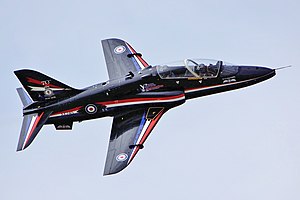 | |
| BAE Hawk T1 trainer of the Royal Air Force | |
| Role | Advanced trainer aircraft |
National origin | United Kingdom |
| Manufacturer | Hawker Siddeley (1974–1977) British Aerospace (1977–1999) BAE Systems MAI division |
| First flight | 21 August 1974 |
| Introduction | 1976 |
| Status | In service |
| Primary users | Royal Air Force Indian Air Force Finnish Air Force Royal Australian Air Force |
| Produced | 1974–present |
Number built | 1,000+ |
Unit cost | £18 million (2003) |
| Variants | British Aerospace Hawk 200 |
Developed into | McDonnell Douglas T-45 Goshawk |
The BAE Systems Hawk is a British single-engine, jet-powered advanced trainer aircraft. It was first flown at Dunsfold, Surrey, in 1974 as the Hawker Siddeley Hawk, and subsequently produced by its successor companies, British Aerospace and BAE Systems, respectively. It has been used in a training capacity and as a low-cost combat aircraft.
Operators of the Hawk include the Royal Air Force (notably the Red Arrows display team) and a considerable number of foreign military operators. The Hawk is still in production in the UK and under licence in India by Hindustan Aeronautics Limited (HAL) with over 900 Hawks sold to 18 operators around the world.
Contents
1 Development
1.1 Origins
1.2 Further development
2 Design
3 Operational history
3.1 United Kingdom
3.2 Finland
3.3 India
3.4 Indonesia
3.5 Malaysia
3.6 Saudi Arabia
3.7 Zimbabwe
3.8 Others
4 Variants
4.1 Hawk T1
4.2 Hawk T1A
4.3 Hawk 50
4.4 Hawk 60
4.5 Hawk 100
4.6 Hawk 120/LIFT
4.7 Hawk 127
4.8 Hawk 128 (Hawk T2)
4.9 Hawk 132
4.10 Hawk 165
4.11 Hawk 200
4.12 T-45 Goshawk
4.13 Advanced Hawk
5 Operators
5.1 Former operators
6 Aircraft on display
7 Specifications (Hawk 128)
8 See also
9 References
10 External links
Development
Origins
In 1964, the Royal Air Force specified a requirement (Air Staff Target, AST, 362) for a new fast jet trainer to replace the Folland Gnat. The SEPECAT Jaguar was originally intended for this role, but it was soon realised that it would be too complex an aircraft for fast jet training and only a small number of two-seat versions were purchased. Accordingly, in 1968, Hawker Siddeley Aviation (HSA) began studies for a simpler aircraft, initially as special project (SP) 117. The design team was led by Ralph Hooper.[1]
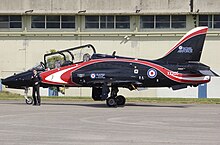
A Royal Air Force Hawk T1A at Kemble Airport, Gloucestershire, with its pilot
This project was funded by the company as a private venture, in anticipation of possible RAF interest. The design was conceived of as having tandem seating and a combat capability in addition to training, as it was felt the latter would improve export sales potential. By the end of the year HSA had submitted a proposal to the Ministry of Defence based on the design concept, and in early 1970 the RAF issued Air Staff Target (AST) 397 which formalised the requirement for new trainers of this type. The RAF selected the HS.1182 for their requirement on 1 October 1971 and the principal contract, for 175 aircraft, was signed in March 1972.[2][3]
The prototype aircraft XX154 first flew on 21 August 1974 from Dunsfold piloted by Duncan Simpson, Chief Test Pilot of HSA (Kingston), reaching 20,000 ft in a flight lasting 53 minutes.[4] All development aircraft were built on production jigs; the program remained on time and to budget throughout.[5] The Hawk T1 entered RAF service in late 1976.[6] The first export Hawk 50 flew on 17 May 1976. This variant had been specifically designed for the dual role of lightweight fighter and advanced trainer; it had a greater weapons capacity than the T.1.[6]
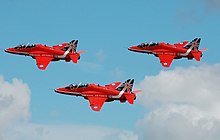
The RAF Red Arrows depart the 2014 Royal International Air Tattoo, England, in a colour scheme that commemorates their 50th year.
More variants of the Hawk followed, and common improvements to the base design typically included increased range, more powerful engines, redesigned wing and undercarriage, the addition of radar and forward-looking infrared, GPS navigation, and night-vision compatibility.[7] Later models were manufactured with a great variety in terms of avionics fittings and system compatibility to suit the individual customer nation; cockpit functionality was often rearranged and programmed to be common to an operator's main fighter fleet to increase the Hawk's training value.[8]
In 1981, a derivative of the Hawk was selected by the United States Navy as their new trainer aircraft. Designated the McDonnell Douglas T-45 Goshawk, the design was adapted to naval service and strengthened to withstand operating directly from the decks of carriers, in addition to typical land-based duties.[9] This T-45 entered service in 1994; initial aircraft had analogue cockpits, while later deliveries featured a digital glass cockpit. All airframes were planned to undergo avionics upgrades to a common standard.[10]
Further development
A major competitor to the Hawk for export sales has been the Dassault/Dornier Alpha Jet; aviation expert John W. R. Taylor commented: "What Europe must avoid is the kind of wasteful competition that has the Hawker Siddeley Hawk and Dassault-Breguet/Dornier Alpha Jet battling against each other in the world market."[11] By early 1998, a total of 734 Hawks had been sold, more than 550 of which had been sold to export customers.[12] Military customers often procured the Hawk as a replacement for older aircraft such as the BAC Strikemaster, Hawker Hunter, and Douglas A-4 Skyhawk.[13]
During the 1980s and 1990s, British Aerospace, the successor company to Hawker Siddeley, was trying to gain export sales of the variable-wing Panavia Tornado strike aircraft; however, countries such as Thailand and Indonesia, which had shown initial interest in the Tornado, concluded that the Hawk is a more suitable and preferable aircraft for their requirements.[14]Malaysia and Oman cancelled their arranged Tornado orders in the early 1990s, both choosing to procure the Hawk, instead.[15] Aviation authors Norman Polmar and Dana Bell stated of the Hawk: "Of the many similar designs competing for a share of the world market, the Hawk has been without equal in performance as well as sales".[9]
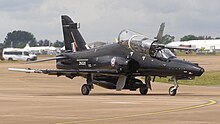
A Hawk T2 of the Royal Air Force in 2009
On 22 December 2004, the Ministry of Defence awarded a contract to BAE Systems to develop an advanced model of the Hawk for the RAF and Royal Navy.[16] The Hawk Mk. 128, otherwise designated as Hawk T2, replaces conventional instrumentation with a glass cockpit, to better resemble modern fighter aircraft such as the new mainstay of the RAF, the Eurofighter Typhoon. In October 2006, a GB£450 million contract was signed for the production of 28 Hawk 128s.[17] The aircraft's maiden flight occurred on 27 July 2005 from BAE Systems' Warton Aerodrome.[18]
According to BAE Systems, as of July 2012, they have sold nearly 1000 Hawks so far, with sales continuing to date.[19] In July 2012, Australian Defence Minister Stephen Smith confirmed that Australia's fleet of Hawk Mk 127s would be upgraded to a similar configuration to the RAF's Hawk T2 as part of a major mid-life upgrade.[20] The Hawk T2 was considered to be a competitor for the United States Air Force's T-X program to acquire a new trainer fleet,[21] but in February 2015, Northrop Grumman determined the Hawk's shortfalls made it ill-suited for the program requirements and dropped it as their offering.[22]
In May 2015, Indian aerospace manufacturer Hindustan Aeronautics (HAL) revealed that it was examining the prospects of performing its own Hawk upgrades, including armed light attack variants. The Indian Air Force, which were in the process of receiving trainer Hawks built under licence by HAL, were reportedly interested in the upgrade proposals, which would also include avionics and cockpit modifications; HAL has stated that it also aims to export combat Hawks to other countries in partnership with BAE. Missile developer and manufacturer MBDA may provide their ASRAAM and Brimstone missiles to arm the new attack type.[23]
Design

T1 Hawk at RAF Mildenhall, Suffolk, 1984
The Hawk is an advanced trainer with a two-man tandem cockpit, a low-mounted cantilever wing and is powered by a single turbofan engine. Unlike many of the previous trainers in RAF service, the Hawk was specifically designed for training.[5] Hawker had developed the aircraft to have a high level of serviceability, as well as lower purchasing and operating costs than previous trainers like the Jet Provost.[24] The Hawk has been praised by pilots for its agility, in particular its roll and turn handling.[25]
The design of the fuselage included a height differential between the two seats of the cockpit; this provided generous levels of visibility for the instructor in the rear seat.[26] Each cockpit is fitted with a Martin-Baker Mk 10B zero-zero rocket-assisted ejection seat.[26] Air is fed to the aircraft's rear-mounted Rolls-Royce Turbomeca Adour engine via intakes on each of the forward wing roots. During the aircraft's development, Hawker had worked closely with Rolls-Royce to reduce the engine's fuel consumption and to ensure a high level of reliability.[24]
Even within the development stages, a Hawk variant was intended to also serve as a single-seat ground-attack fighter; both the trainer and fighter models were developed with the export market in mind.[5] On single seat models, the forward cockpit area which normally houses a pilot is replaced by an electronics bay for avionics and onboard systems, including a fire control computer, multi-mode radar, laser rangefinder and forward-looking infrared (FLIR).[27] Some export customers, such as Malaysia, have extensive modifications to their aircraft, including the addition of wingtip hardpoint stations and a fittable inflight refuelling probe.[28]
 Play media
Play mediaSAAF Hawk landing
The Hawk was designed to be manoeuvrable and can reach Mach 0.88 in level flight and Mach 1.15 in a dive, thus allowing trainees to experience transonic flight before advancing to a supersonic trainer.[29][30] The airframe is very durable and strong, stressed for +9 g; the normal limit in RAF service is +7.5/-4 g.[31] A dual hydraulic system supplies power to operate systems such as the aircraft's flaps, airbrakes and landing gear, together with the flight controls. A ram air turbine is fitted in front of the single tail fin to provide backup hydraulic power for the flight controls in the event of an engine failure;[32] additionally, a gas turbine auxiliary power unit is housed directly above the engine.
The Hawk is designed to carry a centreline gun pod, such as the 30 mm ADEN cannon, two under-wing pylons, and up to four hardpoints for fitting armaments and equipment.[5] In RAF service, Hawks have been equipped to operate the Sidewinder air-to-air missiles. In the early 1990s, British Aerospace investigated the possibility of arming the Hawk with the Sea Eagle anti-ship missile for export customers.[33] In 2016, BAE Systems was developing the so-called 'Advanced Hawk' with a new wing using leading-edge slats, and potentially additional sensors and weapons, a head-mounted display, and a single large-screen display in the forward cockpit.[34]
Operational history
United Kingdom

Hawk T.1A of 234 Squadron, armed with a pair of AIM-9L Sidewinder missiles and a 30mm gun pod
The Hawk entered RAF service in April 1976, replacing the Folland Gnat and Hawker Hunter for advanced training and weapons training. The Hawk T1 was the original version used by the RAF, deliveries commencing in November 1976. The most famous users of the Hawk are the Red Arrows aerobatic team, who adopted the plane in 1979.[35]
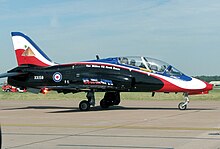
RAF Hawk T1A, marking the 85th anniversary of No. 4 Flying Training School
From 1983 to 1986, some Hawks were equipped as short-range interceptor aircraft. 88 T1s were modified to carry two AIM-9L Sidewinder air-to-air missiles in addition to a 30 mm ADEN cannon gun pod; these aircraft were redesignated as Hawk T1A.[6] In a wartime scenario, they would have worked in collaboration with the RAF's Tornado F3 interceptors, which would use their Foxhunter search radars and more sophisticated navigation systems to vector the Hawks against enemy targets.[36]
The Hawk subsequently replaced the English Electric Canberra for target towing duties. The Royal Navy acquired a dozen Hawk T1/1As from the RAF; these are typically operated in a support role, often to conduct simulated combat training onboard ships.[37]
During the 1990s and 2000s, 80 Hawk T1/1A aircraft were upgraded under the Fuselage Replacement Programme (FRP) to extend their operational lifespan; sections of the centre and rear fuselage sections were entirely replaced.[38] In 2009, the RAF began receiving the first Hawk T2, in the long term, T2 aircraft will replace the ageing T1s.[39] Training operations on the Hawk T2 began in April 2012.[40]
In August 2011, a Red Arrows pilot was killed when his Hawk T1 crashed following a display at the Bournemouth Air Festival, the inquest found "G-force impairment" may have caused the pilot to lose control;[41] the Hawk T1 fleet was grounded as a precautionary measure and returned to flight status a few days later.[42] In November 2011, the Red Arrows suffered another pilot fatality when the Martin-Baker Mk.10 ejection seat fitted to the Hawk T1 activated while the aircraft was stationary; the veteran combat pilot died on ground impact when the ejector seat parachute also failed to deploy.[43] This resulted in the UK Ministry of Defence implementing a ban on non-essential flying in aircraft fitted with ejector seats similar to those fitted in the Hawk T1 after the death.[43] The ban was lifted for Tornado attack jets but remained on Hawk T1, Hawk T2 and Tucano flights while the RAF reviewed evidence on those aircraft.[43]
In October 2017, the RAF and Royal Navy operated 75 Hawk T1 and 28 Hawk T2. According to the Ministry of Defence, the planned out-of-service date for the Hawk T1 is 2030, with the aircraft selected to meet the requirements of the Air Support to Defence Operational Training (ASDOT) programme beginning to replace the Hawk from 2027.[44]
Finland
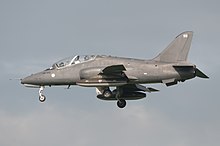
Finnish Hawk in flight, 2011
In January 1978, Britain and Finland announced a deal in which the Finnish Air Force was to receive 50 Hawk Mk. 51s in 1980;[45] these aircraft were built in Finland under licence by Valtion lentokonetehdas. The Finnish Air Force was limited to 60 first-line fighter aircraft by the Paris Peace Treaty of 1947; by acquiring Hawks, which counted as trainers rather than fighters, capacity could be increased while continuing treaty compliance. These conditions were nullified during the 1990s by the break-up of the Soviet Union.[46]
Seven additional Mk. 51As were delivered in 1993–94 to make up for losses. In June 2007, Finland arranged to purchase 18 used Hawk Mk. 66s from the Swiss Air Force for 41 million euros; they were delivered in 2009–2010.[47] Finnish Hawks have reportedly been armed with Russian Molniya R-60/AA-8[48][49] as well as with AIM-9M air-to-air missiles.[50] The Finnish Air Force aerobatics team, the Midnight Hawks, also uses the aircraft.[51]
Due to rising levels of metal fatigue, a major structural reinforcement program was carried out to extend the operational life of Finland's Hawks during the 1990s.[52] Due to lifespan limitations, 41 out of 67 in Finland's total Hawk fleet were taken out of service between 2012–2016; the remaining aircraft are younger and thus are expected to be flying into the 2030s.[53][54] In 2011, Finnish Mk. 51s and Mk. 66s underwent a series of upgrades performed by Patria, these included the adoption of a new Cockpit 4000 glass cockpit, new software, and other life-extending modifications.[55][56] This upgrade program was completed in 2013.[52]
India

Two BAE Systems Hawks of the Indian Air Force
On 23 February 2008, the Hawk Mk. 132 formally entered service with the Indian Air Force (IAF),[57] after one of the most protracted procurements in India's history, two decades having elapsed between the initial interest and the contract signing on 26 March 2004. The IAF received 24 aircraft directly from BAE Systems with deliveries beginning in November 2007, and further 42 Hawks assembled by Hindustan Aeronautics Limited between 2008 and 2011.[58] In February 2008, India planned to order 57 more Hawks, with 40 going to the Indian Air Force and the remaining 17 to the Indian Navy.[59][60]
In July 2010, it was announced that the IAF and the Navy would receive the additional 57 aircraft.[61] The additional aircraft will be all built in India by Hindustan Aeronautics (HAL), continuing to work under licence from BAE.[62] On 10 February 2011, Hindustan Aeronautics Limited and GE Aviation signed a contract under which GE Aviation will conduct the next 30 years of maintenance on the Hawk fleet.[63] In 2011, the IAF was reportedly unhappy with the provision of spare components;[64] In December 2011, BAE received a contract to provide India with spares and ground support.[65]
The first IAF Hawk AJT crashed on 29 April 2008 at 406 Air Force Station Bidar, Karnataka.[66] On 3 June 2015, another Hawk AJT aircraft crashed near Baharagora, close to the West Bengal – Odisha border.[67]
The Hawk fleet is based at IAF's Bidar Air Force Station in north Karnataka, about 700 km from Bangalore. As of 2015, a total of 123 aircraft were on order by the Indian Air Force and 17 by the Indian Navy.[68] An additional order of 20 aircraft is under negotiation.[68]
On 19 February 2019, two Hawk jets of the Indian Air Force's Surya Kiran Aerobatic Team crashed after a mid-air collision over the Yelahanka airbase in north Bengaluru. One of the three pilots have died. The two others, who ejected safely, have been injured and taken to the Command Hospital.
The accident took place at around 11:50 am during a rehearsal session ahead the Aero India 2019.
Indonesia
In April 1978, Indonesia, seeking to increase its aerial capabilities, placed the first of multiple orders for the Hawk.[69] The Indonesian Air Force received more than 40 Hawks in the 1980s and 1990s;[70] In June 1991, BAe and Indonesian Aerospace (IPTN) signed a major agreement for collaborative production of the Hawk, and more orders of the Hawk were anticipated.[71] Further Hawk exports were eventually blocked due to concerns over Indonesian human rights, particularly in East Timor.[70] During the 1990s protests erupted across England over arming Indonesia and pressure increased after the mass-murder of the Balibo Five journalists and Roger East came to light and allegations of the use of Hawks during the Indonesian occupation of East Timor.[72]
The Hawks have been the backbone of Indonesian Air Force, supplementing more advanced and expensive aircraft such as the F-16 Fighting Falcon. In September 2013, the Indonesian Air Force began receiving the KAI T-50 Golden Eagle, which has been reported as having been set to eventually replace the Hawk in service.[73] In February 2016, it was announced that Indonesia's Hawk fleet was set to receive a new radar warning receiver self-defense system, aiding the type's use in light attack operations.[74]
Malaysia
The Royal Malaysian Air Force has 18 Hawk aircraft, consisting of 4 Hawk 108 export versions as training aircraft and 14 Hawk 208 as combat aircraft. On 5 March 2013, during the 2013 Lahad Datu standoff, five Hawk 208 together with three American-made Boeing F/A-18D Hornets were employed in airstrikes on hideouts of the terrorist group Royal Security Forces of the Sultanate of Sulu and North Borneo in Lahad Datu, Sabah ahead of the ground assault by joint forces of the Malaysian Army and Royal Malaysian Police.[75][76]
Saudi Arabia
Saudi Arabia acquired the Hawk under the Al-Yamamah arms deal with Britain, with a total of 50 Hawk Mk. 65/65As ordered in contracts placed in 1985 and 1994 respectively.[77] In August 2012, a deal for 22 Hawk 'Advanced Jet Trainers' worth approximately $800 million was announced. The AJTs would replace older models of Hawks in the Royal Saudi Air Force (RSAF) inventory.[77] The Hawk is flown by the RSAF demonstration team.[77] In February 2016 it emerged that Saudi Arabia had doubled the number of Hawk AJT aircraft it had ordered from BAE Systems, with an order for a further 22. This was revealed in the company's preliminary annual report for 2015; "We reached agreement with the Saudi customer for the provision of a further 22 Hawk AJT aircraft, associated ground equipment, and training aids for the RSAF which form part of an enhancement to the Kingdom's training capacity." Once in service, the Hawk AJTs will complete the replacement of the earlier Mk 65 and Mk 65A platforms.[78]
Zimbabwe
In the 1980s, 12 BAE Hawk T.Mk. 60/60As were purchased for the Air Force of Zimbabwe; the purchase was supported by a GB£35 million loan from the UK to Zimbabwe.[79] The Hawk deal also included the transfer of a number of used Hawker Hunters.[80] In July 1982, at least one Hawk was destroyed on the ground and three more heavily damaged during a dissident attack on Thornhill air base, Gweru.[81]
Zimbabwe's Hawks were used during the Second Congo War. Numerous airstrikes were conducted in support of the Congolese Army against Rwandan, Ugandan and rebel forces in 1998–2000.[82] In 2000, the controversy over Zimbabwe's military intervention in the Congo and poor human rights record led to Britain imposing a total arms embargo on the nation, including spare parts for the Hawk.[83][84] Due to the embargo, Zimbabwe has purchased six Chinese Hongdu K-8s as a substitute.[85][86]
Others
During the 1980s, a prospective sale of 63 Hawk trainers to Iraq was considered by the British government.[87] While the proposal had its proponents, it was controversial as in a ground-attack capacity Iraq might have employed the Hawk against neighbouring Iran and to oppress Iraq's own Kurdish population;[88] there was also concern that the Hawk could be potentially armed with chemical weapons. After considerable deliberation the sale was blocked.[89] In 2010, Iraq entered talks with BAE for an order of up to 21 Hawks.[90]
In 1993, talks between BAe and South Africa's Denel Aviation began regarding a replacement for the South African Air Force (SAAF)'s ageing Atlas Impala fleet.[91] By 2004, Denel had begun construction of Hawks under licence from BAe; components for other customers have also been produced by Denel.[92] On 13 January 2005, the first locally assembled Hawk conducted its first flight; it belonged to a batch of 24 trainers ordered by the SAAF.[93]
Variants
Hawk T1
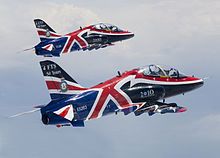
Two Hawk T1s of RAF 208 Squadron in the 2010 display season livery
The Hawk T1 (Trainer Mark 1) was the original version of the Hawk used by the RAF, deliveries commencing in November 1976. The RAF received a total of 175 T1s.[6]
Hawk T1A
The Hawk T1A is a modified Hawk T1, intended to replace the Hawker Hunter in the RAF's Tactical Weapons Units. A total of 89 aircraft were converted to carry two underwing AIM-9L Sidewinder air-to-air missiles and a centreline Aden gun pod.[6] This is also the variant used by the RAF's Red Arrows display team; the underbody gun pod is replaced by a fairing used to carry diesel fuel and dye for the display smoke system.[94]
Hawk 50
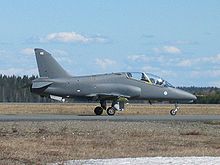
Finnish Air Force Hawk 51 in Rissala AB
The Hawk 50 was the original export trainer version, and offered a limited attack capability. Finland, Indonesia and Kenya ordered 90 of this variant.[6]
Hawk 51 – Export version for the Finnish Air Force. 50 ordered December 1977, with first four to be built by British Aerospace and remaining aircraft assembled in Finland. Delivered December 1980 to September 1985.[95]
Hawk 51A – Seven Hawks were sold to Finland as part of a follow-on order. Powered by Adour 851 engine as used by Hawk 51, but with structural and wing modifications of later Hawks.[96]
Hawk 52 – Export version for the Kenyan Air Force. Fitted with braking parachute. Twelve ordered 9 February 1978, with deliveries from 1980 to 1981.[97]
Hawk 53 – Export version for the Indonesian Air Force. Eight ordered 4 April 1978, with five more ordered in May 1981, a further three in October 1981 and four in November 1982, giving a total of 20 delivered between 1980 and 1984.[96] Five repurchased by BAE Systems in 1999.[98]
Hawk 60
Another export version, replacing the Hawk 50, intended for conversion and weapons training. Weapons carriage is increased. It is a two-seater, has uprated Rolls-Royce Adour 861 engines, and is capable of a level speed at altitude of 555 knots (1028 km/h) or Mach 0.84.[6] The T-45 Goshawk was derived from this version.[99][100]
Hawk 60 – Export version for the Air Force of Zimbabwe. Fitted with braking parachute and provision for carrying a reconnaissance pod. Eight Hawks were ordered by Zimbabwe on 9 January 1981, and delivered between July and October 1982.[101]
Hawk 60A – Five Hawks were sold to Zimbabwe as part of a follow-on order in 1990. The aircraft were delivered between June and September 1992.[101]
Hawk 61 – Export version for Dubai, United Arab Emirates Air Force. Eight ordered 30 June 1981 for a price of $40 million and delivered March to September 1983. Single additional attrition replacement aircraft delivered 1988.[95]
Hawk 63 – Export version for Abu Dhabi, United Arab Emirates Air Force. 16 purchased on 2 January 1983 for $180 million including spares and maintenance support. Delivery between October 1984 and May 1985.[102]
Hawk 63A – 15 Hawk 63s were upgraded to this standard from October 1991, with the Adour 871 engine and Advanced Combat Wing of the Hawk 100, with four underwing weapons pylons and wingtip missile rails, but retaining simpler avionics of Hawk 63.[102][103]
Hawk 63C – Four new build aircraft to Hawk 63A standard were sold to Abu Dhabi as part of a follow-on order and delivered from 1995.[102]
Hawk 64 – Export version for the Kuwait Air Force. Twelve ordered 31 October 1983 and delivered 1985 to 1986.[104]
Hawk 65 – Export version for the Royal Saudi Air Force. 30 ordered as part of Al Yamamah I arms deal in February 1986 with deliveries from August 1987 to October 1988.[98][105]
Hawk 65A – 20 were sold to Saudi Arabia as part of a follow-on order, to an improved standard, and delivered 1997.[98][105]
Hawk 66 – Export version for the Swiss Air Force. Twenty ordered on 20 October 1987, with first built by BAe and remaining 19 assembled by the Federal Aircraft Factory at Emmen. Delivery from November 1989 to October 1991.[106]
Hawk 67 – Export version for the Republic of Korea Air Force. Fitted with extended nose of Hawk 100 to accommodate avionics and a steerable nosewheel. Twenty ordered in July 1991, with delivery by November 1993.[97]
Hawk 100

A Hawk 115 (CT-155) of the Royal Canadian Air Force
A two-seat advanced weapons trainer with additional avionics, an optional forward-looking infrared, a redesigned wing and HOTAS.[107]
Hawk 102 – Export version for Abu Dhabi, United Arab Emirates Air Force. Fitted with wingtip missile rails and Racal Prophet radar warning receiver (RWR). Eighteen ordered in 1989 and delivered between April 1993 and March 1994.[98][102]
Hawk 103 – Lead-in fighter trainer for the Royal Air Force of Oman. Fitted with FLIR and laser ranger in extended nose, BAE Sky Guardian RWR and wingtip AAM rails. Four were ordered on 30 July 1990 and delivered from December 1993 to January 1994.[98][108]
Hawk 108 – Export version for the Royal Malaysian Air Force. Fitted with BAE Sky Guardian RWR and wing tip AAM rails. Ten ordered December 1990, and delivered January 1994 to September 1995.[98][109]
Hawk 109 – Export version for the Indonesian Air Force. (8)
Hawk 115 – Export version for the Canadian Forces, designated CT-155 Hawk in Canadian service.
Hawk 129 – Export version for Royal Bahraini Air Force. (6)
Hawk 120/LIFT

Hawk 120 LIFT of the South African Air Force
The Hawk Lead-in Fighter Trainer (LIFT) is the version selected by the South African Air Force in December 1999. This variant is powered by the Adour 951. The LIFT benefits from development carried out for the Australian Mk. 127.

Hawk 127 of No. 76 Squadron RAAF at Avalon Airport, 2007
The next generation Hawks (120, 127 and 128) feature a new wing, forward and centre fuselage, fin and tailplane.[28] The aircraft have only 10% commonality with the existing first generation aircraft. The new variants also have four times the fatigue life of the original aircraft. 24 aircraft will be delivered.
Hawk 127
The Royal Australian Air Force ordered 33 Hawk 127 Lead-in Fighters (LIFs) in June 1997, 12 of which were produced in the UK and 21 in Australia. This variant is also powered by the Adour 871. The Hawk 127 is operated by the RAAF's No. 76 Squadron and No. 79 Squadron which are based at RAAF Base Williamtown and RAAF Base Pearce respectively. Work to upgrade the RAAF's Hawks to a standard similar to the Hawk 128 standard began in 2014, and it is planned that the two squadrons will begin operations with these aircraft in 2017.[110]
Hawk 128 (Hawk T2)
The Hawk 128 is the new Advanced Jet Trainer (AJT) for the RAF and Royal Navy. The 128 includes modern LCD displays instead of conventional instrumentation and is powered by the Rolls-Royce Adour 951 engine. The Ministry of Defence awarded a Design and Development Contract to BAE Systems on 22 December 2004.[16] The T2 builds on the design of the Australian Mk. 127 and the South African Mk. 120s.[18]
In 2012 orders were placed for the AJT version by the Royal Saudi Air Force and the Royal Omani Air Force.[111][112]
Hawk 132
The Hawk Mk. 132 is an export variant of the Hawk and was previously known as the Mk. 115Y. BAE Systems delivered the final of 24 UK-built Hawks to the IAF in November 2009.[113]HAL handed over the first locally-built Hawk 132 on 14 August 2008.[114] These aircraft are powered by the Rolls-Royce Adour Mk 871 engine.[115]
Hawk 165
The Mk. 165 is an export variant of the AJT currently on order by the Royal Saudi Air Force. The 22 aircraft are to be built in the UK by BAE.[116]
Hawk 200
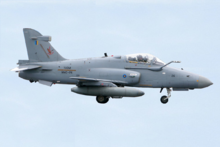
Hawk 208 of the Royal Malaysian Air Force
The Hawk 200 is a single-seat, lightweight multi-role combat aircraft for air defence, air-denial, anti-shipping, interdiction, close air support, and ground attack.[28]
Hawk 203 – Export version for the Royal Air Force of Oman. (12)
Hawk 205 – Proposed export version for the Royal Saudi Air Force.
Hawk 208 – Export version for the Royal Malaysian Air Force. (18)
Hawk 209 – Export version for the Indonesian Air Force. (32)
T-45 Goshawk
The T-45 Goshawk is a carrier-capable aircraft developed from the Hawk 60 for the United States Navy for use in aircraft carrier training.[99]
Advanced Hawk
The Advanced Hawk is a joint venture by BAE Systems and Hindustan Aeronautics Limited, a single example of the aircraft was unveiled at the Aero India 2017 on 14 February 2017.[117][118] It made its first flight in June 2017.[119][120]
Operators
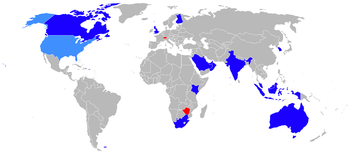
Current operators of the Hawk are shown in dark blue, former operators in red and operators of the T-45 Goshawk in light blue.
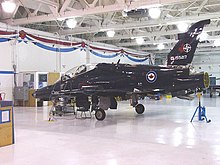
A CT-155 Hawk in Canadian service undergoes maintenance at CFB Moose Jaw, 3 November 2005
 Australia
Australia
Royal Australian Air Force – 33 Hawk 127s[121]
No. 76 Squadron/No. 78 Wing at RAAF Base Williamtown
No. 79 Squadron/No. 78 Wing at RAAF Base Pearce
 Bahrain
Bahrain
Royal Bahraini Air Force – 6 Hawk 129s[122]- No. 5 Squadron at Shaikh Isa
- No. 5 Squadron at Shaikh Isa
 Canada
Canada
Royal Canadian Air Force (formerly Canadian Forces Air Command)[123] – 16 Hawk 115s (CT-155)[124]
2 Canadian Forces Flying Training School/15 Wing at CFB Moose Jaw
 Finland
Finland
Finnish Air Force – 75 Hawks (50 Mk.51, 7 Mk.51A, 18 Mk.66)[needs update]
Fighter Squadron 41 (HävLLv 41)- Finnish Air Force Display Team Midnight Hawks
 India
India
Indian Air Force – 106 Hawk 132s (total 123 ordered for IAF) as of 2015[68]
IAF Aerobatic Team "Surya Kirans" at Bidar Air Force Station
- Bidar Air Force Station
Indian Navy – 17 Hawk 132s (6 additional yet to be delivered)[125][126]
 Indonesia
Indonesia
Indonesian Air Force – 38 Hawk 53/109/209s[127]- 1st Air Squadron "Elang Khatulistiwa" ("Equatorial Eagles"), at Supadio Airport, Hawk 109/209
- 12th Air Squadron "Panther Hitam" ("Black Panthers"), at Pekanbaru/Sultan Syarif Qasim II International Airport, Hawk 109/209
- 15th Air Squadron/Wing 3 at Iswahjudi Air Force Base, Madiun. Hawk 53, 15th Air Squadron Hawks were retired in March 2015, replaced by T-50 Golden Eagles.
 Kuwait
Kuwait
Kuwait Air Force – 10 Hawk 64s as of 2008[127]- No. 12 Training Squadron at Ali AlSalem AB (Flying school)
 Malaysia
Malaysia
Royal Malaysian Air Force – 19 Hawk 108/208s[127]- No. 6 Skuadron "Cakra" at RMAF Labuan
- No. 15 Skuadron "Panther" at RMAF Butterworth
- No. 6 Skuadron "Cakra" at RMAF Labuan
 Oman
Oman
Royal Air Force of Oman – 15 Hawk 103/203s in service in 2008,[127] 8 Hawk 166s on order of which 2 delivered in July 2017.[128][129]- No. 6 Squadron at RAFO Masirah
- No. 6 Squadron at RAFO Masirah

Royal Saudi Air Force Hawk in 2011
 Saudi Arabia
Saudi Arabia
Royal Saudi Air Force – 45 Hawk 65s.[127] 22 Hawk 165s on order.[130]- No. 21 Squadron/No. 7 Wing at Tabuk/King Faisal
- No. 79 Squadron/No. 7 Wing at Tabuk/King Faisal
- No. 88 Squadron/No. 7 Wing at Tabuk/King Faisal
- No. 21 Squadron/No. 7 Wing at Tabuk/King Faisal
 South Africa
South Africa
South African Air Force – 24 Hawk 120s[127]
85 Combat Flying School at AFB Makhado
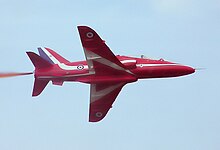
Royal Air Force Aerobatic Team "Red Arrows" Hawk T1

Hawk T1 of the Royal Navy
 United Kingdom
United Kingdom
Royal Air Force – 81 Hawk T1s[127]/28 Hawk T2s
No. 4 Flying Training School
No. IV (R) Squadron at RAF Valley
No. XXV(F) Squadron at RAF Valley
No. 100 Squadron at RAF Leeming
RAF Aerobatic Team "Red Arrows" at RAF Scampton
Joint Forward Air Controller Training and Standards Unit (JFACTSU) at RAF Leeming
RAF Centre of Aviation Medicine at Boscombe Down
Royal Navy – 17 Hawk T1s[127]
736 Naval Air Squadron at RNAS Culdrose
 United Arab Emirates
United Arab Emirates
United Arab Emirates Air Force – 47 Hawk 61/63/102s delivered, 18 in service, 13 63A sold to Jordan
- No. 63 (Advanced Training) Squadron at Al Ain International (Flying Training School – Khalifa bin Zayed Air College)
- No. 102 Squadron at Minhad
Former operators
 Jordan
Jordan
Jordanian Air Force – 13 Hawk 63 delivered from UAE, 12 withdrawn offered for sale [131][132]- 17 Squadron, at Prince Hassan Air Base in lead in fighter training role.
 Kenya
Kenya
Kenya Air Force – 7 Hawk 52s, out of service and retired as of 2012.[citation needed]
 South Korea
South Korea
Republic of Korea Air Force introduced 20 T-59 (Hawk 67) in September 1992.[127] Retired from service in 2013.
- 216th Flight Training Squadron/16th Fighter Wing at Yecheon.
 Switzerland
Switzerland
Swiss Air Force: 20 Hawk Mk. 66s were in service between 1990 and 2002, of which 18 were sold to Finland in June 2007. Replaced by F-5F as an interim measure until the delivery of eight Pilatus PC-21s[citation needed].
 United Kingdom
United Kingdom
- Past units
No. 4 Flying Training School (not current)
- 74 (R) Squadron
- 208 (R) Squadron
No. 6 Flying Training School (not current)
No. 1 Tactical Weapons Unit (not current)
- 79 (R) Squadron
- 234 (R) Squadron
No. 2 Tactical Weapons Unit (not current)
- 63 (R) Squadron
- 151 (R) Squadron
No. 7 Flying Training School RAF (not current)
- 19 (R) Squadron
- 92 (R) Squadron
 Zimbabwe
Zimbabwe
Air Force of Zimbabwe – 12 Hawk 60 retired as of 2011 because of lack of spares and lack of BAE support.[127]- No. 2 Squadron Cobra at Gweru-Thornhill
- No. 2 Squadron Cobra at Gweru-Thornhill
Aircraft on display
- 1 Swiss Air Force Hawk Mk. 66 U-1251 at Flieger-Flab-Museum, Dübendorf, Switzerland
- 1 Royal Canadian Air Force BAE Hawk 115 (CT-155) 155209 at Canadian Warplane Heritage Museum, Hamilton Ontario, CND
- 1 Indonesian Air Force BAe Hawk 53 in front of the Dirgantara Mandala Museum, Indonesia
Specifications (Hawk 128)
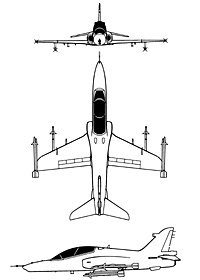

RAF Hawk at Blackpool Airport, 2008
Data from Royal Air Force,[133] BAE Systems,[134] Ministry of Defence[135]
General characteristics
Crew: 2: student, instructor
Length: 12.43 m (40 ft 9 in)
Wingspan: 9.94 m (32 ft 7 in)
Height: 3.98 m (13 ft 1 in)
Wing area: 16.70 m2 (179.64 ft2)
Empty weight: 4,480 kg (9,880 lb)
Useful load: 3,000 kg (6,600 lb)
Max takeoff weight: 9,100 kg (20,000 lb)
Powerplant: 1× Rolls-Royce Turbomeca Adour Mk. 951 turbofan with FADEC, 29 kN (6,500 lbf) 29 kN
Performance
Never exceed speed: Mach 1.2 (in dive)
Maximum speed: Mach 0.84 (1,028 km/h, 638 mph) at altitude
Range: 2,520 km (1,360 nmi, 1,565 mi)
Service ceiling: 13,565 m (44,500 ft)
Rate of climb: 47 m/s (9,300 ft/min)
Thrust/weight: 0.65
Armament
- Note: all armament is optional.
- 1× 30 mm ADEN cannon, in centreline pod
- Up to 6,800 lb (3,085 kg) of weapons on five hardpoints, including:
- 4× AIM-9 Sidewinder or ASRAAM or A-Darter on wing pylons and wingtip rails
- 2x Umbani or Al Tariq
- 1,500 lb (680 kg), limited to one centreline and two wing pylons (Hawk T1)
See also
- Folland Gnat
- Portal:British aircraft since World War II
- SEPECAT Jaguar
Related development
- British Aerospace Hawk 200
- McDonnell Douglas T-45 Goshawk
Aircraft of comparable role, configuration and era
- Aermacchi MB-339
Aero L-39 Albatros / Aero L-159 Alca
- AIDC AT-3
- CASA C-101 Aviojet
- Dassault/Dornier Alpha Jet
- Hongdu JL-8
- IAR 99
- Mikoyan MiG-AT
- Mitsubishi T-2
- PZL I-22 Iryda
- Soko G-4 Super Galeb
- Yakovlev Yak-130
Related lists
- List of active Canadian military aircraft
- List of active United Kingdom military aircraft
References
Citations
^ Flight International 22 November 1986, p. 61.
^ Reed, A., "Modern Combat Aircraft 20: BAe Hawk", Chapter 1 (Ian Allan, 1985) .mw-parser-output cite.citation{font-style:inherit}.mw-parser-output .citation q{quotes:"""""""'""'"}.mw-parser-output .citation .cs1-lock-free a{background:url("//upload.wikimedia.org/wikipedia/commons/thumb/6/65/Lock-green.svg/9px-Lock-green.svg.png")no-repeat;background-position:right .1em center}.mw-parser-output .citation .cs1-lock-limited a,.mw-parser-output .citation .cs1-lock-registration a{background:url("//upload.wikimedia.org/wikipedia/commons/thumb/d/d6/Lock-gray-alt-2.svg/9px-Lock-gray-alt-2.svg.png")no-repeat;background-position:right .1em center}.mw-parser-output .citation .cs1-lock-subscription a{background:url("//upload.wikimedia.org/wikipedia/commons/thumb/a/aa/Lock-red-alt-2.svg/9px-Lock-red-alt-2.svg.png")no-repeat;background-position:right .1em center}.mw-parser-output .cs1-subscription,.mw-parser-output .cs1-registration{color:#555}.mw-parser-output .cs1-subscription span,.mw-parser-output .cs1-registration span{border-bottom:1px dotted;cursor:help}.mw-parser-output .cs1-ws-icon a{background:url("//upload.wikimedia.org/wikipedia/commons/thumb/4/4c/Wikisource-logo.svg/12px-Wikisource-logo.svg.png")no-repeat;background-position:right .1em center}.mw-parser-output code.cs1-code{color:inherit;background:inherit;border:inherit;padding:inherit}.mw-parser-output .cs1-hidden-error{display:none;font-size:100%}.mw-parser-output .cs1-visible-error{font-size:100%}.mw-parser-output .cs1-maint{display:none;color:#33aa33;margin-left:0.3em}.mw-parser-output .cs1-subscription,.mw-parser-output .cs1-registration,.mw-parser-output .cs1-format{font-size:95%}.mw-parser-output .cs1-kern-left,.mw-parser-output .cs1-kern-wl-left{padding-left:0.2em}.mw-parser-output .cs1-kern-right,.mw-parser-output .cs1-kern-wl-right{padding-right:0.2em}
ISBN 978-0-7110-1465-7
^ Donald, D. and Lake, J., eds, "Encyclopedia of World Military Aircraft", Volume 1 (Aerospace Publishing, 1994)
ISBN 978-1-874023-51-7"
^ RAF Museum postal cover "Commemorating the First Flight of the Hawk", 21 August 1974.
^ abcd Field 1976. p. 834.
^ abcdefg Polmar and Bell 2004, p. 388.
^ Polmar and Bell 2004, p. 387-390.
^ "British Aerospace Hawk." Flight International, 22 February 1994.
^ ab Polmar and Bell 2004, p. 387.
^ Polmar and Bell 2004, pp. 387, 389–340.
^ Taylor 1976, p. 63.
^ Phythian 2001, p. 166.
^ Phythian 2001, pp. 156, 239, 246.
^ Phythian 2001, p. 180.
^ Phythian 2001, pp. 180–181, 246.
^ ab "Hawk Advanced Jet Trainer". Hansard Column 333W. 26 January 2005.
^ "BAE lands £450m Hawks contract". Blackpool Today. 20 October 2006.
^ ab "Hawk Mk 128 Makes Maiden Flight" Air Forces Monthly, September 2005, p. 6.
^ Hoyle, Craig. "FARNBOROUGH: BAE close to selling 1,000th Hawk trainer." Flight International, 16 July 2012.
^ Hoyle, Craig. "Australia to upgrade Hawk trainers to RAF's T2 standard " Flight International, 18 July 2012.
^ Hoyle, Craig. "USAF training bosses underscore need for T-X acquisition." Flight International, 20 March 2012.
^ Butler, Amy (6 February 2015). "Northrop Pivots To Clean-Sheet T-X Trainer". Aviation Week. Retrieved 6 February 2015.
^ Chandra, Atul. "HAL eyes export potential of light attack Hawk." Flight International, 28 May 2015.
^ ab Field 1976. pp. 834–835.
^ Field 1976. p. 842.
^ ab Field 1976. p. 835.
^ "Hawk 200 faces a tougher market." New Scientist, 10 July 1986. p. 28.
^ abc Polmar and Bell 2004, p. 389.
^ Donald, David ed. "British Aerospace (HS) Hawk", The Complete Encyclopedia of World Aircraft. Barnes & Nobel Books, 1997.
ISBN 0-7607-0592-5.
^ Field 1976. p. 836.
^ Caliaro, Luigi. In flight with the Red Arrows, A&D Magazine, May 1996, p. 51.
^ Jackson 2003, pp. 479–480.
^ Phythian 2001, p. 181.
^ Pocock, Chris. "BAE Systems Working on ‘Advanced’ Hawk Jet for India." AIN Online, 10 June 2016.
^ "RAF Red Arrows – Team History." Royal Air Force, Retrieved: 25 August 2012.
^ Jane's Defence Weekly, 1986. pp. 395–400.
^ "Inside a Navy Hawk fighter jet." BBC News, 6 May 2009.
^ Gething, Michael J. "RAF Hawk FRP Moves Onwards." Jane's Defence Upgrades, 1 April 2003.
^ "RAF accepts first Hawk T2s but others head for storage". Flight International. 26 February 2009.
^ Hoyle, Craig. "UK ready to launch Hawk T2 training, says RAF." Flight International, 15 March 2012.
^ "Tributes paid to Red Arrows crash pilot Jon Egging". BBC Online. 21 August 2011. Retrieved 2011-08-22.
^ "RAF Hawk jets cleared to fly again." Archived 21 January 2013 at Archive.today Defence Management, 26 August 2011.
^ abc BBC News Lincolnshire, Inquest hears Red Arrows pilot died from fall injuries
^ "Hawk Aircraft:Written question - 107748". UK Parliament. 23 October 2017. Retrieved 26 October 2017.
^ "Britain-Finland barter deal." The Christian Science Monitor, 6 January 1978.
^ O'Dwyer, Gerald (16 October 1990). "Finland looks at German MiG-29s". Flight International. Retrieved 17 August 2011.
^ "Finland Purchases 18 Jet Trainers (Mk. 66) from Switzerland". Defense-aerospace.com. Retrieved 17 August 2011.
^ "Missile armed Hawk BAe Hawk with R-60". Sci.fi. Archived from the original on 26 September 2011. Retrieved 17 August 2011.
^ "Suomi hankkii lisää Hawk-hävittäjiä". Finnish Broadcasting Agency (YLE), 28 June 2007. Retrieved on 28 June 2007. (in Finnish)
^ "Yhteistoimintakierroksia Yhdysvaltain kansalliskaartin kanssa elokuussa". Finnish Air Force, 2 August 2017. Retrieved on 5 August 2017. (in Finnish)
^ "Midnight Hawks home page" (in Finnish). Midnighthawks.fi. 13 August 2011. Retrieved 17 August 2011.
^ ab "Celebrating 35 years of Hawk in Finland." BAE Systems, 17 December 2015.
^ "PARIS AIR SHOW: Finnish air force chief accepts first upgraded Hawk jet trainer." Flight Global, 16 June 2009.
^ "Finnish Air Force decommissioning 41 Hawk trainer jets." Helsingin Sanomat, 5 November 2010.
^ "Defence Professionals: ''Patria delivers first upgraded Hawk jet trainer to the Finnish Air Force ''". Defpro.com. Archived from the original on 17 July 2011. Retrieved 17 August 2011.
^ Pugliese, David. "Esterline CMC Electronics Completes Upgraded Glass Cockpit Deliveries for Finnish Air Force Fleet of Hawk Jet Trainers." Archived 18 July 2012 at the Wayback Machine Ottawa Citizen, 13 July 2012.
^ Kulkarni, Sagar (February 2008). "AJT Hawk inducted into IAF". Archived from the original on 15 March 2008. Retrieved 23 February 2008.
^ Sharma, Ravi (January 2008). "The IAF is set to get 40 more Hawk AJTs". The Hindu. Chennai, India. Retrieved 12 January 2008.
^ Govindasamy, Siva (11 February 2008). "India seeks extra Hawks". Flight International.
^ Luthra, Gulshan; Goel, Ashok (February 2008). "IAF to buy 40 more Hawk Advanced Jet Trainers, Navy to follow with 17". India Strategic.
^ "IAF, Navy to get 57 more Hawk jet trainers". Timesofindia.indiatimes.com. 24 July 2010. Retrieved 17 August 2011.
^ Wilson, Amy (29 July 2010). "BAE wins £500m Hawk order". The Telegraph.
^ "GE Aviation gets license". Pilotsandplanesmilitary.com. 10 February 2011. Archived from the original on 16 August 2011. Retrieved 17 August 2011.
^ "TOI Article – IAF plans for additional Hawks jet trainers shelved". Timesofindia.indiatimes.com. 17 March 2009. Retrieved 17 August 2011.
^ Gooptu, Biswarup (12 December 2011). "BAE Systems secures £59 million Hawk AJ T spares contract from Indian government". Economic Times.
^ Aroor, Shiv (30 April 2008). "BREAKING NEWS: First IAF Hawk AJT Crashes!". LIVEFISTdefence.com. Livefist. Retrieved 14 April 2017.
^ Gupta, Jayanta (3 June 2015). "AJT Hawk crashes after taking off from Kalaikunda". The Times of India. Kolkata: Times News Network. Retrieved 14 April 2017.
^ abc Shukla, Ajai (11 November 2015). "Hawk aircraft proposals to feature in Modi's talks". Business Standard. Bengaluru: Business Standard Private Ltd. Retrieved 14 April 2017.
^ Phythian 2001, p. 163-164.
^ ab Ryan Dilley (29 May 2002). "The 'trainer' jet the UK loves to hawk". BBC News. Retrieved 24 July 2010.
^ Phythian 2001, pp. 156–157.
^ "Death in East Timor: Interview with Maureen Tolfree". BBC Radio 4. 1 December 2003.
^ "Indonesia receives first pair of T-50i advanced jet trainers". Flight International. 13 September 2013. Retrieved 30 November 2013.
^ Jennings, Gareth and Richard Scott. "Singapore Airshow 2016: Indonesia to upgrade Hawk 200/209s with RWR self-protection." IHS Jane's International Defence Review, 16 February 2016.
^ "Security forces stay on full alert". New Straits Times. 6 March 2013. Retrieved 6 March 2013.
^ Kate, Daniel Ten and Barry Porter. "Malaysia Hunts for Philippine Muslim Fighters After Assault." Bloomberg, 5 March 2013.
^ abc "Saudi catches the UK train." Arabian Aerospace, 10 August 2012.
^ "Saudi Arabia orders more Hawk jet trainer aircraft". IHS Jane's 360. 18 February 2016.
^ "UK backed millions in loans for Zimbabwe jets." Archived 22 June 2012 at the Wayback Machine Jubilee Debt Campaign, 8 May 2012.
^ Mitchell, Emily. "UK Arms Exports to Zimbabwe." Archived 7 August 2012 at the Wayback Machine Campaign Against Arms Trade, September 2000.
^ Towers, Roy. ". Year Of Deepening Unease For Security Forces In Zimbabwe." Glasgow Herald, 27 July 1982. p. 5.
^ "Zimbabwe military warns Goma bombings to go on". South African Press Association. 13 May 1999.
^ MacAskill, Ewen. "Britain's ethical foreign policy: keeping the Hawk jets in action." The Guardian, 20 January 2000.
^ "UK halts arms to Zimbabwe." BBC News, 13 May 2000.
^ "Zimbabwe buys six fighter jets." The Guardian, 14 April 2005.
^ "Zimbabwe: 'Purchase of Jets From China Wise'." allafrica.com, 1 July 2005.
^ Scott 1996, p. 560.
^ Scott 1996, p. 564-566.
^ Scott 1996, pp. 567, 570–571.
^ Pfiefer, Sylvia. "Iraq in talks to buy BAE Hawk jets." Financial Times, 29 April 2010.
^ Barrie, Douglas. "BAe in Hawk building talks with South Africa." Flight International, 16 November 1993. p. 4.
^ Kampbell, Keith. "Hawk production under way in South Africa." Engineering News, 14 January 2005.
^ "First SA-assembled Hawk completes maiden flight." 14 January 2005.
^ Fricker World Air Power Journal Volume 22, p. 100.
^ ab Fricker World Air Power Journal Volume 22, p. 104.
^ ab Fricker World Air Power Journal Volume 22, p. 105.
^ ab Fricker World Air Power Journal Volume 22, p. 106.
^ abcdef Jackson 2003, p. 480.
^ ab Donald 2004, p. 175.
^ Frawley 2002, p. 48.
^ ab Fricker World Air Power Journal Volume 22, p. 111.
^ abcd Fricker World Air Power Journal Volume 22, p. 103.
^ Jackson 2003, pp. 478–480.
^ Fricker World Air Power Journal Volume 22, pp. 106–107.
^ ab Fricker World Air Power Journal Volume 22, pp. 108–109.
^ Fricker World Air Power Journal Volume 22, p. 109.
^ Polmar and Bell 2004, pp. 388–389.
^ Fricker World Air Power Journal Volume 22, p. 108.
^ Fricker World Air Power Journal Volume 22, p. 107.
^ Pittaway, Nigel (October–December 2014). "Upgrading the Hawk". Aero Australia (44): 66–67.
^ "Oman, BAE Reach Agreement on Typhoon and Hawk Deal". Defense News. London. 21 December 2012. Archived from the original on 21 December 2012.
^ "Ian King's AGM 2013 speech". BAE Newsroom. BAE Systems. 9 April 2013. Retrieved 14 April 2017.
^ "BAE Systems completes Indian hawk aircraft deliveries". The Indian Express. 6 November 2009. Archived from the original on 1 October 2012. Retrieved 17 August 2011.
^ "First HAL-built Hawk-MK132 aircraft handed over to IAF". The Hindu. India. 14 August 2008. Archived from the original on 11 December 2010. Retrieved 17 August 2011.
^ "HAL to Hand Over first Hawk Jet Trainer to Indian Air Force Thursday". India-defence.com. Retrieved 17 August 2011.
^ "Saudis look to surge pilot training in UK", IHS Jane's 360, IHS Markit, 10 July 2012
^ REVEALED: The BAE-HAL Joint ‘Advanced Hawk’ Livefist Defence 5 February 2017
^ Aero India 2017: India rolls out new Advanced Hawk aircraft Janes.com 20 February 2017
^ https://www.flightglobal.com/news/articles/pictures-baes-advanced-hawk-makes-flight-debut-438065/
^ http://www.baesystems.com/en/article/new-concept-hawk-demonstrator-aircraft-takes-to-the-skies
^ Hoyle Flight International 13–19 December 2011, p. 33.
^ Hoyle Flight International 13–19 December 2011, p. 34.
^ Department of National Defence (March 2007). "CT-155 Hawk". Archived from the original on 11 August 2011. Retrieved 10 June 2011.
^ Hoyle Flight International 13–19 December 2011, p. 36.
^ Chandra, Atul (28 May 2015). "HAL eyes export potential of light attack Hawk". Flightglobal.com. Bangalore.
^ "IAF, Navy to get 57 Hawks by '16". dnasyndication.com, 7/8/2014.
^ abcdefghij "Directory: World Air Forces", Flight International, 11–17 November 2008.
^ Hoyle, Craig (28 June 2017). "PICTURES: Oman takes delivery of its first Typhoons". Flight Global. London. Archived from the original on 17 July 2017. Retrieved 17 July 2017.
^ Jennings, Gareth (31 July 2017). "Oman receives first Hawk jet trainers". IHS Jane's 360. Archived from the original on 31 July 2017. Retrieved 31 July 2017.
^ "Saudi Arabia orders more Hawk jet trainer aircraft | IHS Jane's 360". www.janes.com. Retrieved 2016-02-19.
^ http://www.scramble.nl/orbats/jordan/airforce
^ http://www.rjaf.mil.jo/en/showannouncement-27.html
^ Royal Air Force (29 April 2005). "Hawk 128". Aircraft of the RAF. Retrieved 12 April 2006.
^ BAE Systems. "Hawk". BAE Systems – Air Systems. Archived from the original on 18 March 2006. Retrieved 12 April 2006.
^ "Hawk." Ministry of Defence, Retrieved: 25 August 2012.
Bibliography
.mw-parser-output .refbegin{font-size:90%;margin-bottom:0.5em}.mw-parser-output .refbegin-hanging-indents>ul{list-style-type:none;margin-left:0}.mw-parser-output .refbegin-hanging-indents>ul>li,.mw-parser-output .refbegin-hanging-indents>dl>dd{margin-left:0;padding-left:3.2em;text-indent:-3.2em;list-style:none}.mw-parser-output .refbegin-100{font-size:100%}
- Donald, David. Warplanes of the Fleet. AIRtime Publishing Inc, 2004.
ISBN 1-880588-81-1.
Eden, Paul (ed.). The Encyclopedia of Modern Military Aircraft. London: Amber Books, 2004. ISBN 1-904687-84-9.
- Frawley, Gerard. The International Directory of Military Aircraft, Aerospace Publications Pty Ltd, 2002.
ISBN 1-875671-55-2. - Field, Hugh. "Hawker-Hawk: In The Air." Flight International, 3 April 1976. pp. 834–843.
Fricker, John (1995). "British Aerospace Hawk". World Air Power Journal. London: Aerospace Publishing. 22: 45–111. ISBN 1-874023-62-X. ISSN 0959-7050.
- Hoyle, Craig. "World Air Forces Directory". Flight International, Vol. 180 No. 5231, 13–19 December 2011. pp. 26–52. ISSN 0015-3710.
- Jackson, Paul. Jane's All The World's Aircraft 2003–2004. Coulsdon, UK:Jane's Information Group, 2003.
ISBN 0-7106-2537-5. - Phythian, Mark. The Politics of the British Arms Sales Since 1964. Manchester University Press, 2001.
ISBN 0-719059-07-0.
Polmar, Norman and Dana Bell. One Hundred Years of World Military Aircraft. Naval Institute Press, 2004.
ISBN 1-591146-86-0.- Scott, Richard. Report of the Inquiry into the Export of Defence Equipment and Dual-Use Goods to Iraq and Relationed Prosecutions. The Stationery Office, 1996.
ISBN 0-102627-96-7. - Taylor, John W. R. Jane's All The World's Aircraft 1975–1976. Macdonald, 1976.
ISBN 0-354-00521-9.
External links
| Wikimedia Commons has media related to BAE Hawk. |
- RAF Hawk T1/1A trainer page
- BAE Systems Hawk page
- BAE Hawk at Greg Goebel's AIR VECTORS
- AeroFlight – BAE Systems Hawk
- The Red Arrows
Hawker Siddeley Hawk – British Aircraft Directory